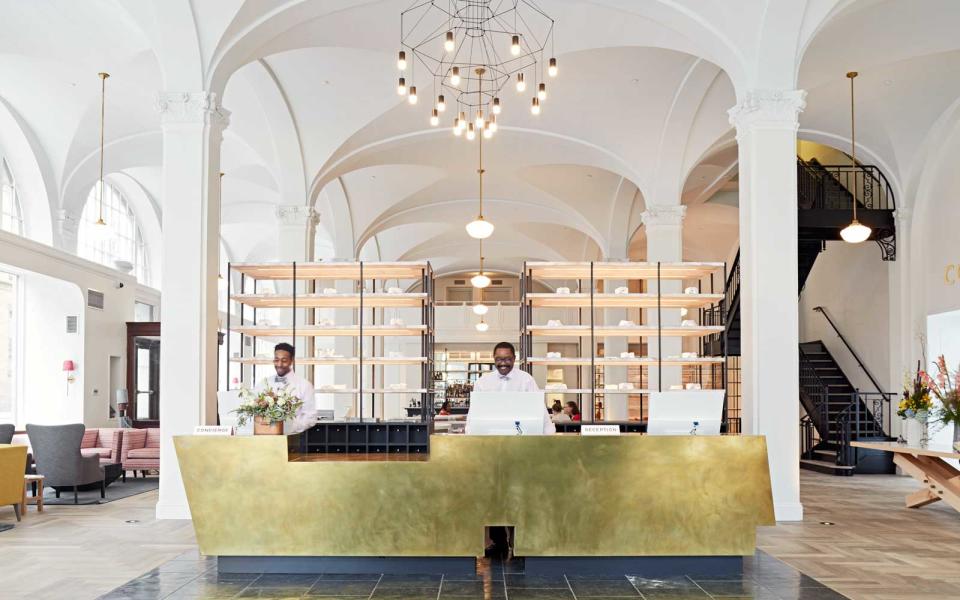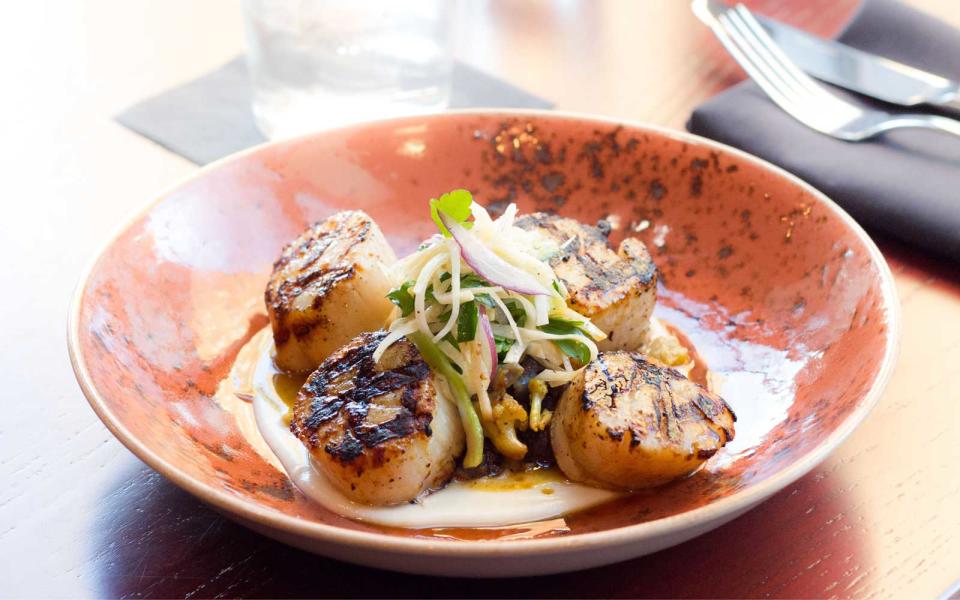A Virginia Road Trip
When I was a child, my family traveled often from our home in California to visit relatives in Virginia, where my father has roots that go back more than three centuries. There were great-aunts, ham biscuits, whole afternoons spent on the back porch absorbing family stories. Back then, the state felt like a place crowded with deft politenesses, historic-house museums, and ancestral ghosts. But on recent trips, I’ve noticed that Virginia has become less ye-olde, more global. Its capital, Richmond, which once languidly muffled the merest ripple of the new, has embraced the current artisanal mood, as if recasting the state's Jeffersonian-farmer roots for the 21st century. “In some ways, it's hipper than Oakland,” Kristen Green, a writer I know from Richmond, told me.
Kristen was one of several friends and family members who would join me for stretches of a lazy loop from Richmond to Charlottesville by way of the Blue Ridge Mountains, then back to Richmond. While much of this trip would be through places I have been visiting since childhood, I’d been wanting to absorb the changing Virginia. The Commonwealth — where Thomas Jefferson, of whom I am a distant descendant, helped forge American democracy while owning slaves — has always embodied American paradoxes. Today it faces American questions: How to merge old and new? How to reconcile the rural with the cosmopolitan? And how to remember its complex past?
Day 1: Richmond
From the vantage of the interstate, it can appear as if Richmond paved over its Civil War wounds with on-ramps and parking lots. But off the freeway, the city’s neighborhoods — settled, like Rome, around seven hills — are having a renaissance. The old brick buildings, once run-down, now house shops bursting with life. Soon to join them is the futuristic Steven Holl–designed Institute for Contemporary Art.
After arriving, I checked in to the Quirk Hotel, a converted 1916 department store where guests can dine at the restaurant, Maple & Pine, under original vaulted ceilings or order a cocktail at the rooftop bar. Then I headed out to explore with my aunt Martha, a Virginia native who has lived in Richmond for nearly four decades. “We didn't used to walk around here,” she said as we wandered the surrounding arts district. That seemed a shame. Richmond is a tremendously fun place to walk, and to eat. Chef Adam Hall's Saison Market in nearby Jackson Ward, where I saw a woman studying Japanese amid shelves stocked with local bitters and jams, might have been any hip spot — but then I tried the fried-chicken biscuit. As I bit into the flaky wonder, I gasped: it was the best I’d had since the last time I'd tasted my great-aunt Nancy’s in the Blue Ridge, years ago. “What’s the secret?” I asked. “Adam's been experimenting, ” the waitress said, winking. “He puts in as much butter as the flour can hold.”

Day 2: Into the Blue Ridge
“I can't leave yet,” I told Kristen the next day as we headed downtown before I hit the road. “We’ve barely started.” The Gothic façades made me think of one of the city's most famous denizens, Edgar Allan Poe, but the energy in the streets was modern. Crisp blazers hung in the flagship of Ledbury, an excellent local men’s-luxury-apparel company. We popped into Black Iris, an artist-run gallery and performance space where Poe has been honored with a raven stenciled onto the wall. We grabbed lunch at Rappahannock, whose owners have been promoting sustainable aquaculture in the Chesapeake region. The oysters had a clean, almost freshwater sweetness. To our delight, there was Prosecco on tap. Kristen insisted on walking me by Mama J’s, a classic soul-food restaurant in Jackson Ward. As we opened the door, the smell of cobbler rushed out. I succumbed to the coconut cake.
The two-lane road out of Richmond, lined with creepers and coppery streams, felt unexpectedly quiet after the excitement of the city. I passed Farmville, the college town where my grandparents met, and got out at Appomattox Court House, the place where General Lee surrendered, now a national historical park. Stately 19th-century buildings edged emerald fields. The afternoon blazed honey. This, too, is quintessentially Virginian: stretching your legs on a battlefield.
About 90 minutes later, I reached the mountain town of Floyd to join my friends Allison and Erika for a jamboree at the Floyd Country Store, a century-old restaurant, candy shop, and weekend music venue. It has become a hub for bluegrass enthusiasts traveling the Crooked Road, a network of rural highways linking music halls across a 300-mile stretch of the Blue Ridge. Outside, a man in a converted short school bus dubbed the Free Tea Bus handed out herbal tea. Inside, the accents were thick, the ladies wore tap shoes, and the gents played spoons. Most of the dancers looked over 70 or under seven. As fiddles wailed and the washboard kept time, a grizzled man named Wilford escorted me to the square dance. We shuffled. We do-si-doed. As we swung our partners, I looked each one in the eye. I could feel how, on the cold rim of a remote mountain, a community needed to dance together this way.
Day 3: Floyd
At the center of town is a store called the Republic of Floyd. It felt fitting for a town so radically its own: at once hardscrabble and hippie. At the farmers’ market, vendors sold fresh-dyed yarn, sausage sandwiches from a makeshift griddle, even kombucha. At one stand, I met James Grant, a bearded craftsman with a callused grip who was hawking stunning hand-turned wooden bowls. When I asked if I could order one online, he pressed a card into my palm. “Just call,” he said. “I’ll find someone who can e-mail you.”
Later, at Foggy Ridge Cider, an orchard so remote we felt we might bump into Johnny Appleseed, Allison and I tasted ciders made from 18th-century apple cultivars. One of them, First Fruit, comes from acidic Hewes crab apples of the sort Jefferson grew to make cider. Afterward, we wandered the orchards. I felt tremendous tenderness for the gnarled trees, for their deep roots.
A sharp wind blew and the clouds thickened, so Allison and I decided to hightail it to Charlottesville. Crossing Nelson County, we saw the storm spread over huge, quilted ranges. It was stunning to behold, but I was still relieved to reach Charlottesville and the charming Oakhurst Inn.

Day 4: Charlottesville
In many ways, this city is the cosmopolitan heart of Virginia. It feels like an extension of Jefferson himself, full of ambitious pursuits. I strolled the Downtown Mall, a main street that was pedestrianized in 1976, a time when many downtown districts faced the wrecking ball, and visited two of my favorite clothing boutiques, Eloise and Bittersweet. I ate a picnic from Salt, a roadside stand, on the lawn of Highland, James Monroe’s estate, gazing at the unspoiled hills and the happy sheep wandering by. I met my historian friend Sara for dinner at C&O, a New American restaurant in an old railroad workers’ bunkhouse where the flavors are delicate and bright, but the walls are crooked and bourbon-dark. An elderly woman in a classic plaid skirt reminded me of my grandmother, 20 years ago. I felt a pang: I realized I love Virginia when it changes, but also when it stays the same.
Day 5: Monticello
I've always been fascinated by Jefferson’s plantation: the maps in the entrance hall, the book collection, the 18th-century orrery, the dumbwaiter he designed to summon bottles of his cider. When I came here as a girl, it was all about Jefferson's genius, as if America had sprung, fully grown, from the great man's head. In recent decades, Monticello’s historians have worked to craft a fuller account. I wandered with my cousin Gayle, who is African-American and also descended from Jefferson, through the inner workings of the estate — the kitchen, the upstairs bedrooms, even the privy — that are now open to the public. Among the most important of Monticello's changes is that it now acknowledges Sally Hemings, the enslaved woman who many historians believe gave birth to several of Jefferson’s children. Gayle and I also saw the cellar from which Burwell Colbert, the enslaved butler, retrieved cider made from crab apples tended by Wormley Hughes, the enslaved gardener. “We no longer use the passive voice,” Susan Stein, the senior curator, told us. “We include everyone in the story.”
Afterward, we walked down to the African-American cemetery at the bottom of the mountain. As I listened to the wind in the trees, I realized that Monticello — and Virginia — call to me precisely because they embody the thorny ways American roots and lives are linked. “Our ancestors are with you,” Gayle said. I knew she was right. As I drove back to Richmond, I sifted contradictions, thinking how I love the way this state's lush woods keep pulling me back — the way they seem, on every visit, to grow more resonant.

The Details: Virginia
C&O Restaurant: A local classic, open since 1976, serves delectable New American concoctions in a former bunkhouse for C&O railroad workers. Charlottesville; entrées $15–$32.
Floyd Country Store: A place for sandwiches, ice cream, hard candy, and authentic Appalachian music, especially during the famous Friday Night Jamboree.
Foggy Ridge Cider: Sample the hard cider at this restored 18th-century farm in the town of Dugspur.
Mama J’s: A Richmond staple for mouthwatering soul food and cakes to die for in a cozy dining room. entrées $8–$15.
Monticello: America’s third president’s plantation is a case study in the state’s complex relationship with its own history. Charlottesville.
Oakhurst Inn: Elegant rooms and suites in chic, walkable, downtown Charlottesville. doubles from $169.
Quirk Hotel: A sophisticated property in a repurposed 1916 department store, with a rooftop bar offering cocktails and views of downtown Richmond. doubles from $270.
Rappahannock Oysters: Harvested from four sustainable aquafarms in the Chesapeake and Chincoteague Bays, the oysters here offer a perfect balance of brine and creaminess. Richmond; entrées $24–$32.
Saison and Saison Market: Chef Adam Hall’s downtown restaurant has added a side market that sells local goods and delicious fried-chicken biscuits. Richmond; entrées $15–$27.
Salt: Purveyor of high-end picnic fare in a rustic former gas station on the Thomas Jefferson Parkway. Charlottesville.

